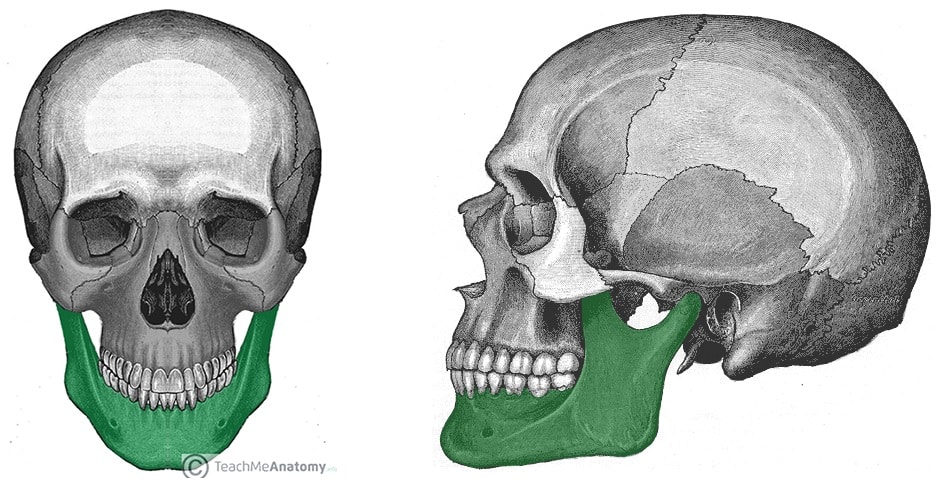Fancy a little movement detectivery you can do for free, from the comfort of your own home?
Well, not completely free… You need the internet (and I don’t know about you, but my rates just went UP!). And you’ll have to stand up and use your brain and your muscles a bit, so it might not be as comfortable as sitting on your butt.
Regardless, if you have jaw issues, hip issues, or both issues, I think you’ll appreciate this little piece of biomechanical investigation. The video below is a simple way to test if your jaw’s resting position (which may be a lil’ off center), is messing with how your hips and pelvis are able to move.
Can you see how when I shift my jaw one way it makes things looks really discombobulated? What’s up with that huh?
The Jaw vs. Hips Test Explanation
In this video I’m testing if the resting position of my lower jaw (mandible) is impacting on my ability to hike my pelvis on either side (and thus adduct/abduct my hips- which needs to happen with every step we take for efficient gait).

Ideally, our pelvis hikes and drops with each foot step we take. We also want our bodies to move as evenly as possible on the right and left sides: Pelvis hike on the right should be pretty dang close to the hike on the left.
In this assessment, we’re looking clean and clear (and under control…) frontal plane motion, meaning purely up and down motion. Not a pelvis rotation. Not a pelvis thrust. Pelvis bones ought to move like elevators, not a washing machine.
In this assessment, pelvis hiking is accomplished by gently bending one knee to allow the opposite side of the pelvis to hike up on it’s own. I’m not trying to use my side-abs to pull my pelvis up with a muscular contraction. This is an assessment of how your pelvis reacts to a knee bend, NOT trying to see how high you can jam your iliac crest into your ear like it’s a contest.
Start by evaluating how each side hikes with your jaw doing it’s natural thang. Note any differences. This is your baseline.
Next, slide your jaw to the RIGHT (like a type-writer). Repeat your pelvis hikes. Notice if that changes anything. Better, same, or worse?
Lastly, slide your jaw to the LEFT. Repeat your pelvis hikes. Notice if that changes anything. More even right and left? Less even? Any discomfort?
Did one of those three jaw positions make your pelvis hikes more even? More comfortable? Worse? Or no difference?
The Results
If you are perceptive, you can probably see which jaw position helps my pelvis and hips achieve more balanced, clean motion.
(FYI my right and left sides are reveresd. My tattoo leg is my right leg…One of my online students actually remarked that it was great to have my right leg so clearly denoted because it helps her keep track of the rights and lefts in class! Yes… I got that tat for exactly that reason… ;))
Here’s the video again, to save you some scrolling:
Round 1: Jaw in it’s default resting position. My pelvis hikes look pretty even right and left, eh?
Round 2: Jaw shifted LEFT. When I hike left side up, I shift off of that leg. And when I hike right, I rotate towards the right instead of hiking. This is NOT clean motion, meaning I have poor access to both pelvis hikes.
Round 3: Jaw shifted RIGHT. This looks very similar to round 1, but in my body it feels smoother and happier.
So, if I had to pick one jaw position that promotes optimal hip motion, jaw shifted right is the winner.
Interpretating the Results
Okay, so what’s the point of this, and what, if any, useful information can we glean from it in the name of better, pain-free movement?
Jaw position is kind of a big deal.
Interestingly, our mandible’s position in our skull dictates a lot about how we’re able to move our hips and pelvis in gait (among other things… THAT’S a rabbit hole of a lifetime that will make you very disappointed in humanity and yet empowered to pay attention to your oral-facial health and tell everyone to shut their dang mouth while they breathe. But don’t get too high on that soapbox…).
We can consider the jaw to be a “leveller” of the body- A mid-line structure with a significant impact on whole body mechanics. What if your body took part of it’s cue for where its center is, based on where your jaw is? What if this had an impact on which phases of gait you can and can’t access (it does)?
So when you notice your jaw is “tight” or clicky or you clench it, know that this is not just a jaw problem- It’s a whole body problem.
What I haven’t mentioned yet is that my jaw’s default resting position is already shifted to the left.
So in round 1 of the test, my jaw is actually sitting slightly left of center. I think it’s been that way since I was at least 3 years old. Why do I think that? Because I have a photo of me on my third birthday in which my jaw looks like it’s pushed farther back on the left side.
Like this:

In round 2 of the test, when I slide my jaw to the left, my pelvis and hips have no clue how to move in the frontal plane! What’s going on here?
As mentioned earlier, hiking the pelvis needs to happen with each footstep. It’s part of our bodies’ shock-absorption mechanics that happens when our foot pronates on the ground, loading the lateral glutes medius and minimus (this is suspension phase of gait for the AiM folks, loading phase for the rest of y’all).
So too does the jaw have it’s own coordinated movement with the whole body in gait for optimal efficiency.
In gait, when the pelvis hikes on one side, the jaw actually needs to slide over and gap (teeth come apart) on that side as part of a whole body pattern for efficient movement.
In another moment in gait, when the right heel hits the ground (heel strike), the jaw actually shifts to the left. Interestingly, right heel strike is a phase in which I experience right hip and SIJ pain sometimes. In fact, right hip pain was the first chronic pain symptom I ever remember having.
So this gets me thinking… How long has my jaw been messing with my hips? Has my resting-left jaw tendency predisposes me to having the hip problems that I did/still do? Have my hips really been on a path of destruction since I was three years old (or even earlier?). I don’t think this is random, or coincidence…
What do you do with this new data?
Let’s say you’re like me, and if you shift your jaw left your pelvis doesn’t know the meaning of “hike”.
Let’s look at the data:
- Where’s my jaw at rest? Shifted left.
- When I shift it MORE left (deeper into default) I can’t hike either side of my pelvis, when I shift it right, things improve.
- Thus my jaw being positioned left is highly likely to be giving my hips and pelvis some grief
- Solution? Getting my jaw to not be stuck to the left all the time and have a more centered default position would likely have a beneficial whole body effect.
The journey from here- what you decide to do, will vary based on the tools you have in your toolkit to reorganize your jaw. Manual therapy, movement re-training, goofy looking face stretches, all can be useful.
For the past 3 years I’ve been on a journey of levelling my jaw. It’s been a fascinating, enriching, and frustrating project.
Here are a few interesting things I’ve noted along the way that have helped me un-leftify my jaw, and significantly improve how my hips feel:
- I prefer to unconsciously chew on the left side. It’s my happy place. I try not to always chew in my happy place.
- When I am in social-anxiety-producing situations, I unconsiously clench my jaw and shift it to the left. It’s where my jaw goes when I’m trying to cope with stress. Now I’m at the point that I’m conscious of it happening. Sometimes I can even NOT DO IT.
- Oral-facial integration techniques (a la MNRI) and craniosacral therapy have been super helpful for me. I can do these manual therapy techniques on myself because our faces are easily within hands-reach. Learning these two modalities have been game-changing.
- Understanding how jaw motion couples with the rest of our bodies in gait, as per the Flow Motion Model taught by Gary Ward in his Anatomy in Motion courses has been crucial for me to use whole body movements to re-integrate my jaw with my body in a meaningful context, i.e. walking. Do you know what your jaw should be doing in three dimensions with a pelvis hike? Well mine isn’t doing the right thing! And reorganizing that has been key.
- I used to get weird popping and ringing sensations in my left ear, especially under stress… Now they are almost gone, but come back when my jaw is more to the left (which happens when I’m under stress).
- Making funny faces is an awesome and important part of changing the way you move 😜 I mean, this is serious business, but that doesn’ t mean we can’t have some serious fun with it.
My invitation to you
Are you feeling like a Movement Detective? This is the kind of stuff I like to share with my students in my secret Movement Detective School. Oops, not so secret anymore…
Give this test a try and see if your jaw could be impacting the motion of your pelvis and hips.
It is quite likely you have one position in which your jaw discombobulates your hips.
Is that the same side you have a clicky, poppy jaw? Is that the same side you chew on primarily? Is that the same side you got smoked in the face by some aggressive jerk in a hockey match? Is that the same side you had a traumatic experience getting your wisdom teeth removed?
Let me know what you find. What if you could free your jaw, free your hips, and free your life? (you can!)
PS I share little videos like this from time to time on my Instagram page. I think social media sucks 90% of the time, but I like to use it to share the nerdy movement things that I do. Feel free to follow me @monvolkmar

